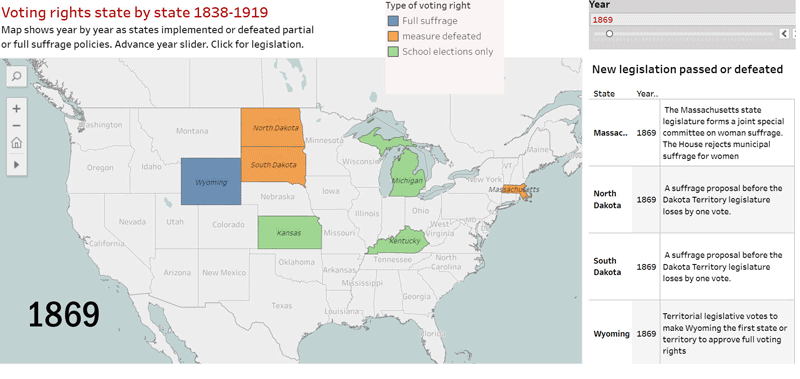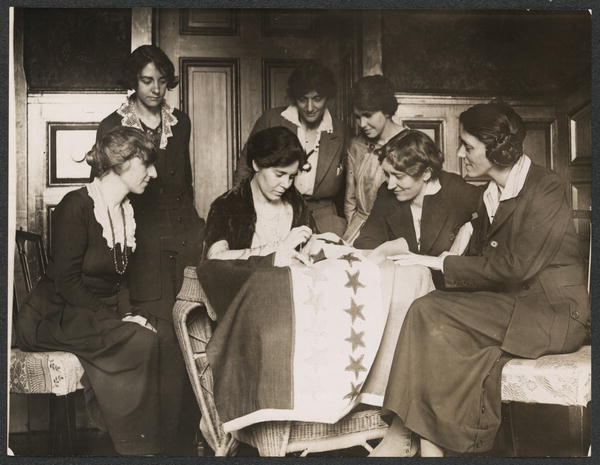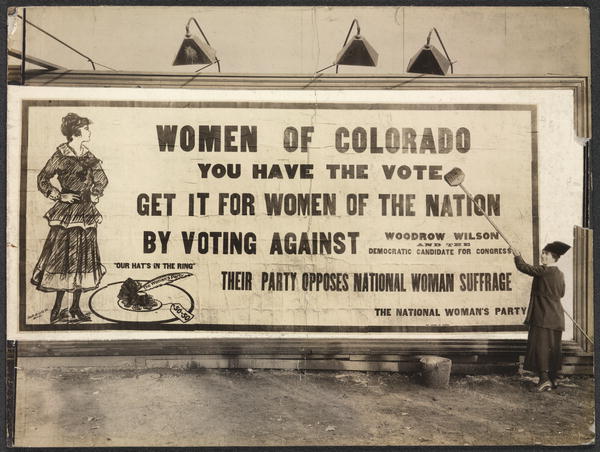Woman Suffrage History and Geography 1838-1920
 Voting rights by states for selected years 1838-1919. Blue means full rights. Green indicates partial suffrage. Orange means voting measure was rejected by legislature or electorate. Click to see a larger view of this interactive year by year timeline and map.
Voting rights by states for selected years 1838-1919. Blue means full rights. Green indicates partial suffrage. Orange means voting measure was rejected by legislature or electorate. Click to see a larger view of this interactive year by year timeline and map.
Here we explore the history and geography of the social movements that began to turn the United States toward democracy, a nation where more than a minority of its citizens participated in elections. Ratified in 1920, the 19th Amendment to the US Constitution required all states to allow women to vote on the same basis as men, but the fight for voting rights had started more than a century earlier and had largely concentrated on changing laws state by state. A proposed Constitutional amendment had been introduced in 1868 at the urging of Susan B. Anthony and Elizabeth Cady Stanton but was quickly sidelined. It was not until Alice Paul and Lucy Burns launched the Congressional Union in 1913 (and the National Woman's Party in 1916), that suffrage activists were finally in a position to force Congress and the President to support a constitutional amendment. But long before that women were winning the vote in state-by-state campaigns that featured clever lobbying and daring protests. Kentucky was first. In 1838, the all-male legislature decided that widows and unmarried women who owned property could vote in school elections. By 1883 fourteen other states allowed women to vote in school elections and in three western territories women had won full voting rights. State-by-state campaigns accelerated after the turn of the century and by 1918, as Congress debated the 19th amendment, women already voted in 20 states.
This project has several units: (1) Timeline and state-by-state map showing where suffrage activists introduced legislation that often failed and at other times yielded only partial voting rights, typically limited to school elections or the right to vote only in municipal or presidential elections. We show the outcome of 249 measures and the changing map of voting rights for women. (2) An illustrated esri Storymap narrating the highlights of the Congressional Union/ National Woman's Party campaign that achieved the seemingly impossible goal of a constitutional amendment. (3)A detailed year-by-year history of Alice Paul, Lucy Burns and the National Woman's Party campaigns. (4) Maps showing the locations of more than 400 NWP actions in Washington DC and arround the country. Katie Anastas is project coordinator.
|
These maps show the fight for votes year by year and state by state as women activists and their allies introduced legislation that often failed and at other times yielded only partial voting rights, often limited to school elections or in some cases only municipal or the presidential election. Here we show the outcome of 249 voting rights measures considered by state legislatures. |
|
This illustrated essay chronicles the actions and accomplishments of this remarkable social movement while displaying more than 50 photographs from the "Women of Protest: Photographs from the Records of the National Woman's Party" (Library of Congress).
|
| This esri StoryMap scrolls through a quick history of the NWP mapping locations of key demonstrations and other actions. Includes almost two dozen historic photographs. .
|
|
From the beginning, the NWP focused tightly on Washington DC. It's first headquarters was some distance from the Capitol, but soon the NWP moved closer, a mere block from the White House. These maps and timeline show the locations of picket lines, arrests, and meetings in the nation's capital.
|
|
Here are maps and charts showing the year-by year geography of the the movement. The NWP organized campaigns in many states while concentrating protest activities in Washington DC. Filter by state and by the type of events. |
|
The Mapping American Social Movements Project is used in hundreds of classrooms at college and high school levels. The maps, charts, and data tables lend themselves to many kinds of observational and interpretative exercises. Here is are several discussion questions for the Woman Suffrage unit. |



